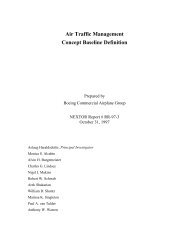Chapter 11: Weather Theory - FAA
Chapter 11: Weather Theory - FAA
Chapter 11: Weather Theory - FAA
Create successful ePaper yourself
Turn your PDF publications into a flip-book with our unique Google optimized e-Paper software.
Height of mercury(760 mm)29.92"At sea level in a standardatmosphere, the weightof the atmosphere(14.7 lb/in 2 ) supportsa column of mercury29.92 inches high.Atmospheric pressureSea levelTo provide a common reference, the International StandardAtmosphere (ISA) has been established. These standardconditions are the basis for certain flight instruments andmost aircraft performance data. Standard sea level pressureis defined as 29.92 "Hg and a standard temperature of 59 °F(15 °C). Atmospheric pressure is also reported in millibars(mb), with 1 "Hg equal to approximately 34 mb. Standard sealevel pressure is 1,013.2 mb. Typical mb pressure readingsrange from 950.0 to 1,040.0 mb. Constant pressure charts andhurricane pressure reports are written using mb.Since weather stations are located around the globe, all localbarometric pressure readings are converted to a sea levelpressure to provide a standard for records and reports. Toachieve this, each station converts its barometric pressure byadding approximately 1 "Hg for every 1,000 feet of elevation.For example, a station at 5,000 feet above sea level, with areading of 24.92 "Hg, reports a sea level pressure reading of29.92 "Hg. [Figure <strong>11</strong>-8] Using common sea level pressurereadings helps ensure aircraft altimeters are set correctly,based on the current pressure readings.29.92 "Hg = 1,013.2 mb (hPa) = 14.7 lb/in 2Figure <strong>11</strong>-6. Mercurial barometer.An aneroid barometer is an alternative to a mercurialbarometer; it is easier to read and transport. [Figure <strong>11</strong>-7] Theaneroid barometer contains a closed vessel, called an aneroidcell that contracts or expands with changes in pressure. Theaneroid cell attaches to a pressure indicator with a mechanicallinkage to provide pressure readings. The pressure sensingpart of an aircraft altimeter is essentially an aneroidbarometer. It is important to note that due to the linkagemechanism of an aneroid barometer, it is not as accurate asa mercurial barometer.HigherBy tracking barometric pressure trends across a large area,weather forecasters can more accurately predict movementof pressure systems and the associated weather. For example,tracking a pattern of rising pressure at a single weather stationgenerally indicates the approach of fair weather. Conversely,decreasing or rapidly falling pressure usually indicatesapproaching bad weather and, possibly, severe storms.Altitude and Atmospheric PressureAs altitude increases, atmospheric pressure decreases. Onaverage, with every 1,000 feet of increase in altitude, theatmospheric pressure decreases 1 "Hg. As pressure decreases,the air becomes less dense or “thinner.” This is the equivalentof being at a higher altitude and is referred to as densityaltitude (DA). As pressure decreases, DA increases and hasa pronounced effect on aircraft performance.Atmospheric pressureSealed aneroid cellSealed aneroid cellLowerDifferences in air density caused by changes in temperatureresult in a change in pressure. This, in turn, creates motion inthe atmosphere, both vertically and horizontally, in the formof currents and wind. The atmosphere is almost constantlyin motion as it strives to reach equilibrium. These neverendingair movements set up chain reactions which cause acontinuing variety in the weather.Sealed aneroid cellFigure <strong>11</strong>-7. Aneroid barometer.<strong>11</strong>-5
















